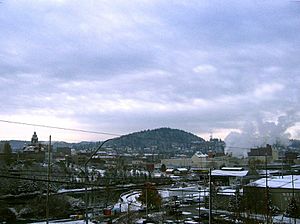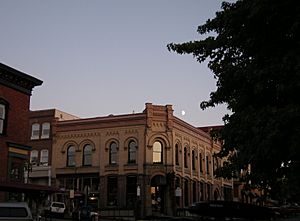History of Bellingham, Washington facts for kids
The history of Bellingham, Washington, as it is known today, started when people began settling in Whatcom County in the mid-to-late 1800s.
The city's name comes from the bay it sits on. George Vancouver visited the area in June 1792. He named the bay after Sir William Bellingham, who managed accounts for the Royal Navy.
Contents
Early Settlers and Native Peoples
When the first European settlers arrived in 1854, the coastal areas around Bellingham Bay had been home to Coast Salish peoples for thousands of years. The land where Bellingham is now located was given to European Americans by local Native American tribes, including the Lummi people. This happened through the Treaty of Point Elliott in 1855, which was a controversial agreement. The Lummi people still live in the area, many on Lummi Peninsula across the bay from Bellingham.
Local stories say that a man known as "Blanket" Bill Jarman was the first white person to live here. The first main settlement was called Whatcom. It was located where Whatcom Creek flows into the bay. The name "Whatcom" comes from a local Native American word meaning "noisy water," referring to the waterfalls at the creek's mouth.
Here, Captain Henry Roeder and Russel Peabody built a lumber mill. They learned about the waterfalls from Lummi leader Chow’it’sut. A fire later destroyed the mill in 1873. Roeder also started coal mining in the area that became known as Sehome. This name came from a member of the nearby Samish Indian tribe.
A fort called "Fort Bellingham" was built on Peabody Hill. Captain George E. Pickett commanded it. He arrived in 1856 and later became a famous general for the Confederate States Army in the American Civil War. Pickett's house is still the oldest house in the city. Fort Bellingham was located just outside the current city limits, near a road still called "Ft. Bellingham."
Bellingham's Early Days
In 1858, the Fraser Canyon Gold Rush brought thousands of miners and others north from California. Whatcom quickly grew from a small mill town into a busy seaport. It became the starting point for the Whatcom Trail, which led to the goldfields. This trail was used even though Governor James Douglas said people should only enter the gold colony through Victoria, British Columbia.
The first brick building in Washington was built this same year. It was the T. G. Richards and Company Store. This building still stands today and is being restored. It later served as the courthouse until 1884.
The first newspaper in Whatcom County, the Northern Light, was published during this busy time. But the gold rush boom ended as quickly as it began. Miners were soon required to get a permit in Victoria, B.C., before going to the goldfields. Whatcom's population quickly dropped, and the town became quiet again.
In the early 1890s, three railroad lines arrived. These connected the bay cities to a national market for builders. After the 1906 San Francisco earthquake, the forests around Bellingham were cut down. This lumber helped rebuild San Francisco. Over time, many lumber and shingle mills opened across the county.
A book called "The Living" by Annie Dillard tells a fictional story about early Bellingham.
Four Towns Become One
The City of Bellingham officially became one city on November 4, 1903. It was formed by joining four smaller towns around Bellingham Bay: Whatcom, Sehome, Bellingham, and Fairhaven. So, Bellingham's history includes the stories of each of these settlements.
Whatcom was on the north end of the bay. Then came Sehome along the eastern shore. Fairhaven was laid out on the southern end of the bay. The small town of Bellingham, originally between Sehome and Fairhaven, was the last to form in 1890. It was soon added to Fairhaven. A year later, Whatcom and Sehome joined to become New Whatcom, which later went back to being called Whatcom. The name "Bellingham" was chosen as a compromise for the final merger. This was because all the towns were on Bellingham Bay.
Coal mining was common near town from the mid-1800s to the mid-1900s. Henry Roeder first found coal off the northeastern shore of Bellingham Bay. In 1854, investors from San Francisco started the Bellingham Bay Coal Company. By 1866, Darius Ogden Mills bought and reorganized the company.
The Sehome Coal Mine, near present-day Laurel Street, employed 100 people in 1860. It made money until it closed in 1878. The company then focused on selling its land around Bellingham Bay.
The Blue Canyon mine, at the south end of Lake Whatcom, opened in 1891. It supplied lower-grade bituminous coal for the United States Pacific Fleet. A terrible accident happened there on April 8, 1895, causing many lives to be lost. The Blue Canyon mine closed in 1917.
That same year, the Bellingham Coal Mines opened near Northwest and Birchwood Avenues. This mine had hundreds of miles of tunnels, some as deep as 1200 feet. It employed about 250 miners. At its busiest in the 1920s, it dug over 200,000 tons of coal each year. It closed in 1955.
In 1889, a group of investors formed the Bellingham Bay Improvement Company (BBIC). These were wealthy businessmen from California. They invested a lot in Bellingham, hoping it would become a major city for business and trade. The BBIC invested in shipping, coal, mining, railroads, real estate, and utilities. Even though Bellingham didn't become a huge metropolis, the BBIC greatly helped its economic growth.
The BBIC provided electricity to Bellingham. This power mainly went to street lighting and electric streetcars. By 1903, the small generator was not enough for the growing city. The BBIC started building a hydroelectric plant on the Nooksack River. However, maintaining the generator and building the new plant was difficult for the BBIC. In 1905, they sold their utility businesses to Stone & Webster.
Other companies were also interested in Bellingham's utilities. General Electric Company of New York bought Bellingham's street rail lines in 1897. By 1902, Stone & Webster had bought these lines. They also acquired other local utility companies. Stone & Webster organized these under the name Whatcom County Railway and Light Company.
The Bellingham Riots happened on September 5, 1907. A group of 400-500 white men wanted to remove East Indian immigrants from local jobs. They attacked waterfront housing. Some people were hurt, and many East Indians were forced to leave town. Many Chinese, Japanese, and Filipino residents also left. No one was punished for these actions. On the 100th anniversary of the riots, Bellingham's mayor declared a "day of healing and reconciliation." This was to remember the sad event.
Fairhaven's Story
In 1861, a man known as "Dirty Dan" Harris bought much of the land that is now Fairhaven for a small amount of money. He planned out the town in 1883 and gave it its current name. A group of investors from Seattle and Tacoma bought the town. They hoped to create a big city that would compete with Seattle and Tacoma. In 1903, Fairhaven had about 5,500 people. Its main industries included fishing, sawmills, and shipyards. A single canning factory employed a thousand people.
In the 1890s, during a time of rapid growth, the grand Fairhaven Hotel was built. It was meant to attract railroad owners to choose Fairhaven as the end point for cross-country railways. The railways never came. The large hotel stood until a fire and demolition in 1953.
In 1903, Fairhaven received money to build the area's first library funded by Andrew Carnegie. This library is on 12th Street and still operates as a branch of the Bellingham Public Library.
Bellingham's Salmon Fishing History
Salmon fishing was always important for food. But large-scale commercial salmon fishing began around 1900. At that time, wire fish traps could catch 30 tons of fish at once. Most fish were canned for shipping. At one point, the Pacific American Fisheries cannery in Fairhaven was the largest salmon processing plant in the world. Canneries were among the city's biggest employers from 1900 to 1945. They were even bigger than the coal and lumber industries.
By 1925, eight salmon canneries operated in Whatcom County. Two were on Bellingham Bay, and the rest were at Lummi Island, Semiahmoo, and Chuckanut Bay. Together, they packed almost half a million cases of salmon in one year.
However, the efficient canneries and fish traps eventually greatly reduced the number of salmon. Fish traps were banned in the 1930s. This caused canneries to move their fishing operations to Alaska. Salmon were still plentiful there, and traps were still allowed. Bellingham's location near the Strait of Juan de Fuca and the Inside Passage to Alaska helped keep some cannery operations here. For example, P.A.F. (Pacific American Fisheries) shipped empty cans to Alaska. There, they were filled with fish and shipped back to Bellingham for storage.
Growth of Western Washington University
In 1899, the main building (now called Old Main) of the New Whatcom Normal School was completed. This was a college for training teachers. By the 1930s, the school became the Western Washington College of Education. It continued to focus on teacher training. In 1961, the school grew into a larger institution that offered many different degrees. It was renamed the Western Washington State College. Today, Western Washington University has about 14,000 students.
Late 20th Century Events
Pipeline Accident and Safety Efforts
On June 10, 1999, the Olympic Pipeline broke in Whatcom Falls Park near Whatcom Creek. It leaked a large amount of gasoline into the creek. Investigators found that the accident was caused by damage from a construction crew. This damage was not reported to the pipeline company or any authorities. The pipeline carries gasoline, diesel, and jet fuel from four refineries to distribution centers. It supplies fuel for places as far south as Portland, Oregon, including all the fuel for Seattle-Tacoma International Airport.
Sadly, an 18-year-old man who was fishing in the creek was affected by the gasoline fumes and drowned. An explosion then happened, started by two young boys playing with a lighter. The explosion burned over a mile of the creek bed. It sent a black smoke cloud high into the air. The two boys, Steven Tsiorvias and Wade King, both 10 years old, were students at a nearby school. They were rushed to the hospital but later passed away due to severe burns. Although some buildings were destroyed, no more lives were lost because roads were closed and people were evacuated. The explosion caused over $45 million in property damage.
Years later, the families of the victims sued the Olympic Pipeline Company. They reached a settlement of about $100 million. The families promised to use this money to support pipeline safety and help other victims of pipeline accidents.
Because of the efforts of the Tsiorvias and King families, a part of the money from the legal settlement was used to start the independent Pipeline Safety Trust. This organization works to make pipelines safer across the country.




